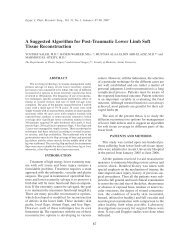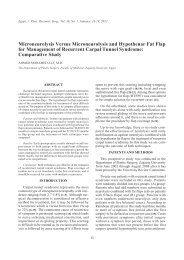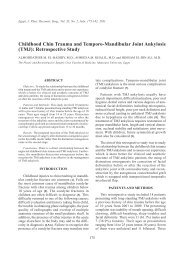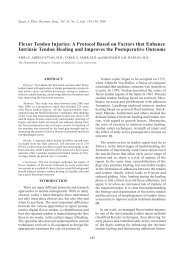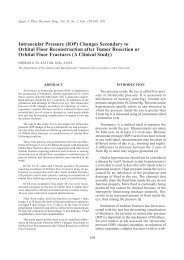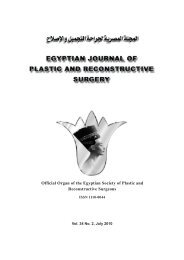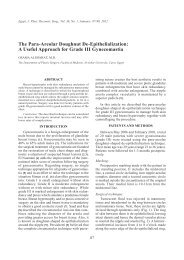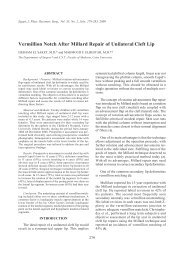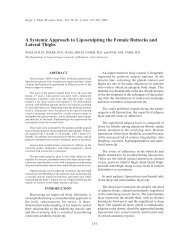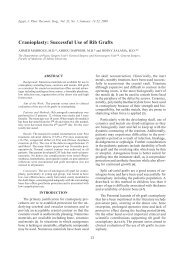Lower Lip Reconstruction with Fujimori Gate Flaps - ESPRS
Lower Lip Reconstruction with Fujimori Gate Flaps - ESPRS
Lower Lip Reconstruction with Fujimori Gate Flaps - ESPRS
Create successful ePaper yourself
Turn your PDF publications into a flip-book with our unique Google optimized e-Paper software.
320 Vol. 27, No. 2 / <strong>Lower</strong> <strong>Lip</strong> <strong>Reconstruction</strong> <strong>with</strong> <strong>Fujimori</strong> <strong>Gate</strong> <strong>Flaps</strong><br />
and Burn Unit, Mansoura University Hospitals,<br />
Egypt, during the period from March 2000<br />
through March 2003. The mean age was 3 years<br />
<strong>with</strong> a range of 2-6 years. The mean time from<br />
initial burn to reconstruction was 4.3 months (a<br />
range 3-6 months). The follow up was 9 months.<br />
Operative technique [4&5]:<br />
The whole of the affected lower lip is excised<br />
as a rectangle (Fig. 1A, BB’ DD’). The inferior<br />
margin of resection (DD’) follows the mentolabial<br />
groove. Whenever possible, a 3-to 4-mmwide<br />
strip of labial mucous membrane is left<br />
attached near the labioalveolar sulcus. The lateral<br />
margin of resection (BD and B’D’) is usually<br />
placed 0.5 to 1.0 cm laterally to perpendiculars<br />
dropped from the labial commissures (OO’), but<br />
it may extend 2 cm laterally in older patients<br />
<strong>with</strong> wrinkled faces. The width of the nasolabial<br />
skin-muscle-mucosal flaps (BC = DE, B’C’ =<br />
D’E’) is usually 3 cm and the suture lines of the<br />
flap donor sites (AED, A’E’D’) should follow<br />
the natural nasolabial fold. The dotted lines<br />
(AIB, AmC, A’T’B’, A’m’C’) represent incisions<br />
made through the mucous membrane, which<br />
should be about 1 cm wider than the flap itself,<br />
so excess mucous membrane can be available<br />
for reconstruction of the new red lip.<br />
When making flap incisions CED and C’E’D’<br />
below the line CC’ that connects both labial<br />
commissures, only skin and subcutaneous tissue<br />
should be cut, keeping the muscle and mucous<br />
membrane intact in the flap pedicle. Further<br />
undermining of the flap pedicle skin is required<br />
to allow flap rotation. <strong>Flaps</strong> prepared in this<br />
fashion contain innervated muscles: orbicularis<br />
oris, caninus, zygomaticus major or minor, riso-<br />
rius, triangularis and buccinator. As soon as the<br />
flaps have been mobilized, incisions should be<br />
closed in the four layers of mucous membrane,<br />
muscle layer, subcutaneous tissue and skin. The<br />
excess mucous membrane over the upper border<br />
of the transposed flap is used to replace vermilion.<br />
This new red lip will be thinner than the<br />
normal lip. Because of cicatricial contraction,<br />
the newly reconstructed lower lip tends to become<br />
puffy and rounded. This distortion can be<br />
effectively corrected by keeping continuous<br />
pressure on the lower lip by the sponge fixation<br />
method for 3 months postoperatively.<br />
RESULTS<br />
Nineteen procedures had been performed to<br />
reconstruct the lower lip in 19 patients: Bilateral<br />
<strong>Fujimori</strong> <strong>Gate</strong> <strong>Flaps</strong> were used in 13 patients<br />
<strong>with</strong> microstomia (Fig. 2) and Unilateral <strong>Fujimori</strong><br />
<strong>Gate</strong> <strong>Flaps</strong> were applied in 6 patients <strong>with</strong> commissural<br />
asymmetry (Fig. 3).<br />
All flaps survived. The flaps were rotated<br />
well <strong>with</strong>out dog ears. The perfusion was reliable.<br />
The healing period was short. The edema resolved<br />
completely in 6 months and the results<br />
were quite satisfactory. There was no need for<br />
defatting or other secondary procedures. There<br />
were no difficulties in maintaining oral competence<br />
or <strong>with</strong> drooling in any patient. Patients<br />
are provided <strong>with</strong> a generous and functional oral<br />
aperture that allowed oral hygiene and oral<br />
feeding <strong>with</strong>out anatomical constriction. <strong>Lip</strong><br />
sensation and motion were entirely preserved.<br />
Donor site morbidity was nil. The color and<br />
texture are nearly equal to those of adjacent<br />
tissues. The follow up period was 9 months.<br />
Fig. (1): <strong>Gate</strong> flap. A: Distance OB = O’B’ = 0.5 to 1.0 cm in normal patients, but it can be extended to 2 cm in the case of older patients<br />
<strong>with</strong> wrinkled faces. Distance BC = B’C’ = 3 cm. Skin incision along AB and AC should be made through-and-through into the<br />
mouth. Skin incision along CE and ED should be made only through subcutaneous tissue. Incision in the mucous membrane is<br />
performed along the dotted lines (A/B, AmC, A’I’B’, A’m’C’) that run laterally to the skin incision lines (AB, AC). Dotted area is<br />
undermined subcutaneously. B: Suture lines run along the nasolabial fold and mentolabial groove centrally (From <strong>Fujimori</strong>, ref. [5]).





